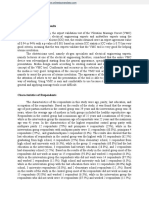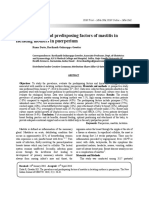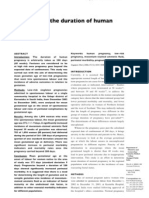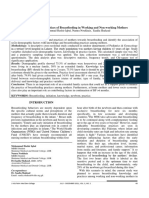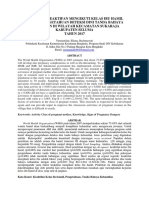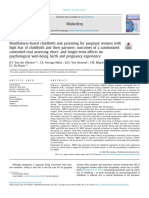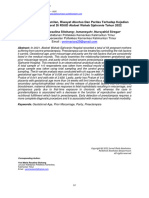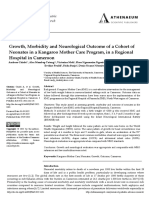Professional Documents
Culture Documents
Study of Prolonged Pregnancy Between 40-42 Weeks
0 ratings0% found this document useful (0 votes)
45 views3 pagesProlongation of pregnancy complicates up
to 10% of all pregnancy and increases the risk to mother
and fetus. Post term pregnancy along with its dreaded
complications causes significant anxiety for mother as
well as obstetrician
Copyright
© © All Rights Reserved
Available Formats
PDF, TXT or read online from Scribd
Share this document
Did you find this document useful?
Is this content inappropriate?
Report this DocumentProlongation of pregnancy complicates up
to 10% of all pregnancy and increases the risk to mother
and fetus. Post term pregnancy along with its dreaded
complications causes significant anxiety for mother as
well as obstetrician
Copyright:
© All Rights Reserved
Available Formats
Download as PDF, TXT or read online from Scribd
0 ratings0% found this document useful (0 votes)
45 views3 pagesStudy of Prolonged Pregnancy Between 40-42 Weeks
Prolongation of pregnancy complicates up
to 10% of all pregnancy and increases the risk to mother
and fetus. Post term pregnancy along with its dreaded
complications causes significant anxiety for mother as
well as obstetrician
Copyright:
© All Rights Reserved
Available Formats
Download as PDF, TXT or read online from Scribd
You are on page 1of 3
Volume 6, Issue 1, January – 2021 International Journal of Innovative Science and Research Technology
ISSN No:-2456-2165
Study of Prolonged Pregnancy between 40-42 weeks
Vibha Pandey1, Swati Shiradkar2
1 2
Junior Resident , Professor and HOU , Department of Obstetrics and Gynaecology, M.G.M Medical College and Hospital,
Aurangabad, Maharashtra, India
Abstract:- year of life, increase in NICU admission and still birth
birth[3,4].The placenta ceases to grow causing placental
Introduction: Prolongation of pregnancy complicates up insufficiency. The baby continues to grow but the placental
to 10% of all pregnancy and increases the risk to mother growth stops[5,6]. Post term pregnancy along with its dreaded
and fetus. Post term pregnancy along with its dreaded complications, is also cause of significant anxiety for mother
complications causes significant anxiety for mother as as well as the obstetrician. With improved antenatal care
well as obstetrician. Aim & objectives: To study the like dating scan and other antenatal diagnostic capabilities
maternal and foetal outcome in prolonged pregnancy there is early recognition of condition and thereby leading to
who delivered between 40-42 weeks. Material and increased incidence of medical and surgical intervention
method: The study was carried out in the Department of before 42 weeks. As a result pregnancy rarely pregnancy
Obstetrics and Gynaecology, Mahatma Gandhi Medical goes beyond 42 weeks. Post term pregnancy is a proved risk
College and hospital, Aurangabad from March 2019- factor for maternal and foetal complications but postdated
March 2020.Total 237 antenatal women were included in pregnancy is less studied. So, 40-42 weeks is a grey zone
the study who presented to MGM OPD and labor room and hence, here is the attempt made to study the maternal
during 40-42 weeks of gestational age. Results: There and foetal outcome of prolonged pregnancy who delivered
was no difference in percentage of spontaneous onset of between 40-42 weeks.
labour in both the groups. The proportion was more in
direct LSCS in 41-42 weeks but it is not statistically Aim and Objectives:
significant. There is no significant difference in bishop 1. To study the maternal outcome in prolonged pregnancy.
score of two groups. Response to induction was 2. To study the foetal outcome in prolonged pregnancy.
significantly good in 41-42 weeks in spite of no
significant difference in the bishop score. Unfavourable II. MATERIAL AND METHODS
foetal outcome was slightly more in 41-42 weeks. Atonic
PPH was the most common maternal complication in 41- Study period: March 2019-March 2020
42 weeks and the reason for ICU admission was Study Design: Cross sectional study.
haemorrhagic shock. Conclusion: Spontaneous onset of Study place- Department of Obstetrics and Gynaecology,
labour was same in both the groups so waiting beyond 41 Mahatma Gandhi Medical College and Hospital,
weeks may not necessarily improve the chances of Aurangabad.
spontaneous onset. After induction the occurrence of Sample size-237
vaginal delivery was more in 41-42 weeks, but maternal
and foetal complications also increased in this group. We Data included the demographic information,
should individualise each case to go beyond 41 weeks information on reproductive history, clinical presentation,
and more efforts should be made on the ripening of mode of delivery and complications that occurred during the
cervix to decrease the chances of LSCS. pregnancy, delivery and neonatal period.
Keywords:- Prolonged Pregnancy, Post Dated Pregnancy, Inclusion Criteria: All antenatal women who presented to
Post Term Pregnancy, Induction Of Labour, Maternal And MGM OPD and labor room during 40-42 weeks of
Fetal Outcome. gestational age were included in the study.
I. INTRODUCTION Exclusion Criteria: None
Fernando Arias defines prolonged pregnancy as those Observation and Results:
pregnancies beyond the expected date of delivery. [1] Post- Total number of deliveries from March 2019 – March 2020
dated pregnancy is defined as pregnancy beyond 40 weeks = 3105
of gestation and post-term is beyond 42 weeks of gestational Total patients in the study (40-42 weeks): 237
age. Prolongation of pregnancy complicates up to 10% of all Incidence of prolonged pregnancy in my study is: 7.6%
pregnancies and carries increased risk to mother and fetus. [2] Divided into 2 groups
The maternal complications are labour dystocia, operative Group A (40-40.6 weeks) - 211
vaginal delivery, increased incidence of LSCS, increased Group B (41-42 weeks) – 26
incidence of PPH. The foetal complications are increased
incidence of macrosomia, polycythemia , foetal distress,
meconium aspiration, dysmaturity, infant death in the first
IJISRT21JAN238 www.ijisrt.com 1060
Volume 6, Issue 1, January – 2021 International Journal of Innovative Science and Research Technology
ISSN No:-2456-2165
Table no: 1 - Spontaneous onset of labour Table no 5: Direct LSCS (N=52)
GROUP Yes No Total Maternal Foetal causes Total
40-40.6 76 (36%) 135 (64%) 211 (100%) causes
weeks 40-40.6 28(63.63%) 16(36.36%) 44 (100%)
41-41.6 9 (34.61%) 17 (65.38%) 26 (100%) weeks
weeks 41-42 6 (75%) 2 (25%) 8(100%)
Total 85 152(64.14%) 237(100% ) weeks
(35.86%) Total 34(65.38%) 18(34.61%) 52(100%)
Chi square: 01 P- value: 0.88 Chi square: 0.790602
Probability: 0.929
In both the groups, there was no difference in
percentage of spontaneous onset of labour Out of the maternal causes for direct LSCS in group A
, and group B the most common maternal cause was
Table no 2: Patients with no spontaneous onset of labour previous LSCS who are not induced according to the
(N=152) department protocol. In group A, the most common foetal
INDUCED DIRECT TOTAL cause was foetal distress. In group B most common foetal
LSCS cause was severe oligohydramnios.
40-40.6 91(67.40%) 44(32.60%) 135(100%)
weeks Table no 6: Foetal outcome
41-42 9(52.94%) 8(47.06%) 17(100%) Favourable Unfavourable Total
weeks 40- 195 (92.42%) 16 (7.58%) 211 (100%)
Total 100(65.785) 52(34.21%) 152(100%) 40.6
weeks
Chi square: 1.40 P value = 0.236 41-42 23 (88.46%) 3 (11.54%) 26 (100%)
The proportion was more in direct LSCS in 41-42 weeks but weeks
it was not statistically significant. Total 219(92.4%) 18(7.59%) 237(100%)
Table no 3: Bishop score (N=100) Chi square: 01
Unfavourable Favourable Total Probability: 0.885
40-40.6 20(21.97%) 71(78.02%) 91(100%) Unfavourable foetal outcome was slightly more in group B
weeks
41-42 2 (22.2%) 7 (77.7%) 9(100%) Table no 7: Maternal Complications
weeks Atonic ICU DEATH
22(22%) 78(78%) 100(100%) PPH
40-40.6 0 1 0
Chi square: 0.54 WEEKS
Probability: 0.941 41-42 2 1 0
No significant difference in the Bishop score of two groups. WEEKS
TOTAL 2 2 0
Table no 4: Induction of labour (N=100)
GROUP VAGINAL LSCS TOTAL The reason for ICU admission in group A was not
40-40.6 60 (65.93%) 31 (34%) 91 (100%) related to pregnancy. The reason for ICU admission in
weeks group B was haemorrhagic shock.
41-42 9 (100%) 0 9(100%)
weeks III. DISCUSSION
TOTAL 69(69%) 31(31%) 100(100%)
In my study, in both the group there was no difference
Chi square: 4.41 in percentage of spontaneous onset of labour. In my study
Probability 0.035 35% went into spontaneous onset of labour. In a study
conducted by Shetal Prajapati et.al only 26% went into
Response to induction was significantly good in group spontaneous onset of labour.[7]
B inspite of no significant difference in the Bishop score.
In my study, no significant difference in the bishop
Note 1: Induction of labour was done using Dinoprost gel. score of the two groups. This result was supported by a
Misoprostol was not used for induction as per institutional study conducted by Daniella Nave et.al that bishop score is
protocol. not a good predictor for success of labour induction. [8] In a
Note 2: Two patients required oxytocin for augmentation of similar study Kolkman et.al bishop score is poor predictor
delivery in each group. for outcome of induced labour.[9]
IJISRT21JAN238 www.ijisrt.com 1061
Volume 6, Issue 1, January – 2021 International Journal of Innovative Science and Research Technology
ISSN No:-2456-2165
In my study, response to induction of labour was [7]. Prajapati S, Chavda D. Retrospective study of post
significantly good in the 41-42 weeks in spite of no term pregnancy and its outcome. Int J Reprod
significant difference in the bishop score. A study done by Contracept Obstet Gynecol 2017;6:4274-6
Ahmad Akram et.al it was observed that induction of labour, [8]. Navve D, Orenstein N, Ribak R, Daykan Y, Shechter-
the chances of vaginal delivery was more. [10] In a study by Maor G, Biron-Shental T. Is the Bishop-score
Nikhil Anand et.al it concluded that after induction of labour significant in predicting the success of labor induction
occurrence of vaginal deliveries was more. [11] in multiparous women? J Perinatol. 2017
May;37(5):480-483.
Induction of labour increases [9]. Kolkman DG, Verhoeven CJ, Brinkhorst SJ et al The
occurrence of vaginal deliveries bishop score as a predictor of labor induction success:
My study Significant A systematic review. Am J Perinatol 2013; 30: 625–
Ahmad Akram Significant 630
et.al [10]. Ahmad Akram, Isha Patel, S.V. Anandhi et al, Clinical
Nikhil Anand et.al Significant Observation of dinoprostone to induce labor in
postdatism: success, side-effect, acceptability;
In my study, unfavourable foetal outcome was slightly International Journal of Medical and Pharmaceutical
more in group B. In a study conducted by Cheng et.al. also Sciences2013; Vol.03(08)P.14-21
revealed that the risk of adverse perinatal outcome increases [11]. Anand N et al. A clinical study of maternal outcome in
gradually after 41 weeks.[12] post dated pregnancy in a tertiary care hospital Int J
Reprod Contracept Obstet Gynecol. 2019
In my study, the reason for ICU admission in 40-40.6 Sep;8(9):3573-3577
weeks and not related to pregnancy. The reason for ICU [12]. Cheng YW, Bruckner TA Caughey AB. Increased
admission in the group 41-42 weeks was haemorrhagic neonatal mortality among post-term births in
shock due to PPH. In a study Galal et. all the rate of PPH California. Am J Obstet Gynecol. 2008;199:421
increased by the weeks of gestation.[13] [13]. Galal M., Symonds I., Murray H., Petraglia F., Smith
R. Postterm pregnancy. Facts Views Vis.
IV. CONCLUSION ObGyn. 2012;4:175–187
Spontaneous onset of labour was same in both the
groups so waiting beyond 41 weeks may not necessarily
improve the chances of spontaneous onset. After induction
the occurrence of vaginal delivery was more in 41-42
weeks, but maternal and foetal complications also increased
in this group. We should individualise each case to go
beyond 41 weeks and more efforts should be made on the
ripening of cervix to decrease the chances of LSCS.
REFERENCES
[1]. Fernando Arias, Practical guide to high risk pregnancy
and delivery 3 Edition; India Harcourt private limited;
2008:255-270
[2]. Olesen AW, Westergaard JG, Olsen J. Perinatal and
maternal complications related to post term delivery: a
national register-based study, Am. J Obstet Gynecol.
1978-1993;189:222-227
[3]. Chaudhari SN, Bhikane DB, Gupta P. A clinical study
of postdated pregnancy. Int J Reprod Contracept
Obstet Gynecol 2017;6:2077- 82
[4]. Cunningham FG, Leveno KJ, Bloom SL, Hauth JC,
Larry CG, Wenstrom KD. Post-term pregnancy. 23rd
ed. In: William’s Obstetrics. New York: McGraw-Hill
Companies; 2010:832-41
[5]. Hovi M, Raatikainen K, Heiskanen N, Heinonen S.
Obstetric outcome in post-term pregnancies: time for
reappraisal in clinical management. Acta Obstet
Gynecol Scand. 2006; 85(7): 805 -9
[6]. Burkitova A.M., Polyakova V.O., Bolotskikh V.M.,
Kvetnoy I.M. Features of the placenta structure in
post-term pregnancy // Journal of obstetrics and
women's diseases. – 2019,Vol. 68.N.6,P. 73-86.
IJISRT21JAN238 www.ijisrt.com 1062
You might also like
- Eclampsia: An Enigma: Chitra JoshiDocument4 pagesEclampsia: An Enigma: Chitra JoshiM Haris Yoga IswantoroNo ratings yet
- Predictive Value of Various Risk Factors For Preterm Labor: Original ArticleDocument5 pagesPredictive Value of Various Risk Factors For Preterm Labor: Original ArticleDuma MargarethaNo ratings yet
- Association of Vaginal Infections in Preterm Labour: Srilakshmi Yarlagadda, Sajana G., Prasuna J. L. NarraDocument6 pagesAssociation of Vaginal Infections in Preterm Labour: Srilakshmi Yarlagadda, Sajana G., Prasuna J. L. NarraNurRahMatNo ratings yet
- A Prospective Study On The Perinatal Outcome in Cases of Previous One Cesarean SectionDocument4 pagesA Prospective Study On The Perinatal Outcome in Cases of Previous One Cesarean SectionIJAR JOURNALNo ratings yet
- Medip, IJRCOG-12438 ODocument4 pagesMedip, IJRCOG-12438 On2763288No ratings yet
- 15 JMSCRDocument5 pages15 JMSCRVani Junior LoverzNo ratings yet
- Maternal Anemia As A Risk Factor For Preterm Delivery and Low Birth WeightDocument2 pagesMaternal Anemia As A Risk Factor For Preterm Delivery and Low Birth WeightCarla LagNo ratings yet
- A Prospective Study On The Maternal Outcome in Cases of Previous One Cesarean SectionDocument6 pagesA Prospective Study On The Maternal Outcome in Cases of Previous One Cesarean SectionIJAR JOURNALNo ratings yet
- PostpartumDocument4 pagesPostpartumghaffari.eli5912No ratings yet
- Mental and Physical StresDocument10 pagesMental and Physical StresfrehanyaqNo ratings yet
- Comparative Study of Micronised Progesterone Versus ISOXSUPRINE IN THE PREVENTION OF PRETERM LABOURDocument7 pagesComparative Study of Micronised Progesterone Versus ISOXSUPRINE IN THE PREVENTION OF PRETERM LABOURshivareddychNo ratings yet
- Cerclage Twins EJOGRB 2024Document6 pagesCerclage Twins EJOGRB 2024Willans Eduardo Rosha HumerezNo ratings yet
- Knowledge and Practice of Postnatal Mothers On Newborn Care at Hospital SettingDocument6 pagesKnowledge and Practice of Postnatal Mothers On Newborn Care at Hospital SettingABUBAKARNo ratings yet
- Use of Cervical Length, Measured by Transvaginal Sonography at 22 To 26 Weeks, As A Predictor of Preterm Labour in Twin Pregnancy - 13 Aug 2018Document6 pagesUse of Cervical Length, Measured by Transvaginal Sonography at 22 To 26 Weeks, As A Predictor of Preterm Labour in Twin Pregnancy - 13 Aug 2018Dr B PathakNo ratings yet
- Research: Outcomes of Elective Induction of Labour Compared With Expectant Management: Population Based StudyDocument13 pagesResearch: Outcomes of Elective Induction of Labour Compared With Expectant Management: Population Based StudyAndinNo ratings yet
- Gui 214 CPG0809Document11 pagesGui 214 CPG0809Dennis GuzmanNo ratings yet
- Journal Homepage: - : Manuscript HistoryDocument6 pagesJournal Homepage: - : Manuscript HistoryIJAR JOURNALNo ratings yet
- Hasil Dan Pembahasan - Id.enDocument6 pagesHasil Dan Pembahasan - Id.enKirana Aulia PutriNo ratings yet
- Early Onset and Late Onset Preeclampsia-Maternal and Perinatal Outcomes in A Rural Teritiary Health CenterDocument4 pagesEarly Onset and Late Onset Preeclampsia-Maternal and Perinatal Outcomes in A Rural Teritiary Health CenterPutri Maghfirah BahriNo ratings yet
- 366-Article Text-1782-1-10-20230930Document6 pages366-Article Text-1782-1-10-20230930Elang kurniati Elang kurniatiNo ratings yet
- Pi Is 0022346814000360Document6 pagesPi Is 0022346814000360Amriansyah PranowoNo ratings yet
- Factor InfluenceDocument5 pagesFactor InfluenceCandra WahyuniNo ratings yet
- 0528Document5 pages0528dokter muda obgynNo ratings yet
- Perceived Birth Trauma in Macedonian WomenDocument10 pagesPerceived Birth Trauma in Macedonian WomenJonathan GrandasNo ratings yet
- Pemberian Asuhan Keperawatan pada Masa Pandemi CovidDocument7 pagesPemberian Asuhan Keperawatan pada Masa Pandemi Covidadelia iaaNo ratings yet
- TafeseDocument28 pagesTafeseWubishet TeferaNo ratings yet
- (2020) Induction of Labour at Term Increase Risk of SC For Advanced Maternal AgeDocument7 pages(2020) Induction of Labour at Term Increase Risk of SC For Advanced Maternal AgeaninditaNo ratings yet
- To Determine The Pregnancy Outcomes in Patients With Previous Spontaneous AbortionsDocument13 pagesTo Determine The Pregnancy Outcomes in Patients With Previous Spontaneous AbortionsIJAR JOURNALNo ratings yet
- Knowledge, Attitude and Practice Exercise During Pregnancy Among Antenatal Mothers at KondencheryDocument8 pagesKnowledge, Attitude and Practice Exercise During Pregnancy Among Antenatal Mothers at KondencheryEditor IJTSRDNo ratings yet
- A Re-Look at The Duration of Human Pregnancy: Bhat R A, Kushtagi PDocument5 pagesA Re-Look at The Duration of Human Pregnancy: Bhat R A, Kushtagi PjackofmanytradesNo ratings yet
- Robsons Ten Group Classification of Cesarean Section at A Tertiary Center in NepalDocument6 pagesRobsons Ten Group Classification of Cesarean Section at A Tertiary Center in NepalgehanathNo ratings yet
- Journal Homepage: - : IntroductionDocument4 pagesJournal Homepage: - : IntroductionIJAR JOURNALNo ratings yet
- Original Article Knowledge & Practices of Breastfeeding in Working and Non-Working MothersDocument6 pagesOriginal Article Knowledge & Practices of Breastfeeding in Working and Non-Working Mothersbilal.ahmed1222No ratings yet
- Ong 139 391Document9 pagesOng 139 391abdi syahputraNo ratings yet
- Manuskrip YusmanidarDocument9 pagesManuskrip YusmanidaryusNo ratings yet
- Mindfulness Based Childbirth and Parenting For Pregnant Women With H - 2023 - MiDocument11 pagesMindfulness Based Childbirth and Parenting For Pregnant Women With H - 2023 - MiAt PrimaNo ratings yet
- 03 MB27011-Naura - RL - Final 2Document5 pages03 MB27011-Naura - RL - Final 2Yoya LoyaNo ratings yet
- 2021 04 29 21256327v1 FullDocument33 pages2021 04 29 21256327v1 Fullangel.paternina423No ratings yet
- Jurnal DR - SugengDocument13 pagesJurnal DR - SugengKanafie El NBilaNo ratings yet
- A Retrospective Study of Incidence of Teenage Pregnancy in Tertiary Care Center-Maternal and Fetal OutcomeDocument8 pagesA Retrospective Study of Incidence of Teenage Pregnancy in Tertiary Care Center-Maternal and Fetal OutcomeIJAR JOURNALNo ratings yet
- Hubungan Usia Kehamilan Riwayat Abortus Dan ParitaDocument9 pagesHubungan Usia Kehamilan Riwayat Abortus Dan ParitaRahma AuliaNo ratings yet
- A Study of Intrauterine Fetal Death in A Tertiary Care HospitalDocument4 pagesA Study of Intrauterine Fetal Death in A Tertiary Care HospitalintanNo ratings yet
- 1 +MJHS+ElfiraDocument13 pages1 +MJHS+ElfiraOcy BikeNo ratings yet
- Improving Outpatient Medical Abortion For Women During The Covid-19 PandemicDocument6 pagesImproving Outpatient Medical Abortion For Women During The Covid-19 PandemicCentral Asian StudiesNo ratings yet
- Paediatrica Indonesiana: Guslihan D Tjipta, MD Riza I Nasution, MD Dachrul Aldy, MD Zakaria Siregar, MDDocument4 pagesPaediatrica Indonesiana: Guslihan D Tjipta, MD Riza I Nasution, MD Dachrul Aldy, MD Zakaria Siregar, MDIin Fadhilah Utami NewNo ratings yet
- Guidelines For The Management of Pregnancy at 41+0 To 42+0 Weeks SOGC Clinical Practice GuidelineDocument11 pagesGuidelines For The Management of Pregnancy at 41+0 To 42+0 Weeks SOGC Clinical Practice GuidelineAlexander AcostaNo ratings yet
- Infant and Young Child FeedingDocument31 pagesInfant and Young Child FeedingCSJDM Nutrition UnitNo ratings yet
- BDI Scores and Risk of Breast Disease and CancerDocument6 pagesBDI Scores and Risk of Breast Disease and CancerRenz MacionNo ratings yet
- Evaluation of Postpartum Female Sterilizations: A Retrospective Study at Tertiary Care Hospital in JammuDocument6 pagesEvaluation of Postpartum Female Sterilizations: A Retrospective Study at Tertiary Care Hospital in JammuIJAR JOURNALNo ratings yet
- Pediatric MedicalsDocument20 pagesPediatric Medicalsalexandra stanescuNo ratings yet
- Best Papers From The Last 10 YearsDocument103 pagesBest Papers From The Last 10 YearsLopez Lopez Jose AngelNo ratings yet
- Composition of Vaginal Microbiota and Their Antibiotic Susceptibility in Symptomatic WomenDocument6 pagesComposition of Vaginal Microbiota and Their Antibiotic Susceptibility in Symptomatic WomenAmirah MohdNo ratings yet
- Title/TopicDocument2 pagesTitle/TopicBtob meloNo ratings yet
- Fix 22 (P)Document4 pagesFix 22 (P)Akreditasi Bendilwungu23No ratings yet
- A Study of Perinatal Outcome of Non Reactive Non Stress TestDocument3 pagesA Study of Perinatal Outcome of Non Reactive Non Stress TestIjsrnet EditorialNo ratings yet
- 1238 8440 1 PBDocument6 pages1238 8440 1 PBKriti KumariNo ratings yet
- Growth Morbidity and Neurological Outcome of A Cohort of Neonates in A Kangaroo Mother Care Program in A Regional Hospital in CameroonDocument8 pagesGrowth Morbidity and Neurological Outcome of A Cohort of Neonates in A Kangaroo Mother Care Program in A Regional Hospital in CameroonAthenaeum Scientific PublishersNo ratings yet
- Obstetric and Gynecology JournalDocument3 pagesObstetric and Gynecology JournalSiti AlfianaNo ratings yet
- Pregnancy Tests Explained (2Nd Edition): Current Trends of Antenatal TestsFrom EverandPregnancy Tests Explained (2Nd Edition): Current Trends of Antenatal TestsNo ratings yet
- A Curious Case of QuadriplegiaDocument4 pagesA Curious Case of QuadriplegiaInternational Journal of Innovative Science and Research TechnologyNo ratings yet
- Analysis of Financial Ratios that Relate to Market Value of Listed Companies that have Announced the Results of their Sustainable Stock Assessment, SET ESG Ratings 2023Document10 pagesAnalysis of Financial Ratios that Relate to Market Value of Listed Companies that have Announced the Results of their Sustainable Stock Assessment, SET ESG Ratings 2023International Journal of Innovative Science and Research TechnologyNo ratings yet
- Adoption of International Public Sector Accounting Standards and Quality of Financial Reporting in National Government Agricultural Sector Entities, KenyaDocument12 pagesAdoption of International Public Sector Accounting Standards and Quality of Financial Reporting in National Government Agricultural Sector Entities, KenyaInternational Journal of Innovative Science and Research TechnologyNo ratings yet
- Food habits and food inflation in the US and India; An experience in Covid-19 pandemicDocument3 pagesFood habits and food inflation in the US and India; An experience in Covid-19 pandemicInternational Journal of Innovative Science and Research TechnologyNo ratings yet
- The Students’ Assessment of Family Influences on their Academic MotivationDocument8 pagesThe Students’ Assessment of Family Influences on their Academic MotivationInternational Journal of Innovative Science and Research Technology100% (1)
- Pdf to Voice by Using Deep LearningDocument5 pagesPdf to Voice by Using Deep LearningInternational Journal of Innovative Science and Research TechnologyNo ratings yet
- Fruit of the Pomegranate (Punica granatum) Plant: Nutrients, Phytochemical Composition and Antioxidant Activity of Fresh and Dried FruitsDocument6 pagesFruit of the Pomegranate (Punica granatum) Plant: Nutrients, Phytochemical Composition and Antioxidant Activity of Fresh and Dried FruitsInternational Journal of Innovative Science and Research TechnologyNo ratings yet
- Forensic Evidence Management Using Blockchain TechnologyDocument6 pagesForensic Evidence Management Using Blockchain TechnologyInternational Journal of Innovative Science and Research TechnologyNo ratings yet
- Improvement Functional Capacity In Adult After Percutaneous ASD ClosureDocument7 pagesImprovement Functional Capacity In Adult After Percutaneous ASD ClosureInternational Journal of Innovative Science and Research TechnologyNo ratings yet
- Machine Learning and Big Data Analytics for Precision Cardiac RiskStratification and Heart DiseasesDocument6 pagesMachine Learning and Big Data Analytics for Precision Cardiac RiskStratification and Heart DiseasesInternational Journal of Innovative Science and Research TechnologyNo ratings yet
- Optimization of Process Parameters for Turning Operation on D3 Die SteelDocument4 pagesOptimization of Process Parameters for Turning Operation on D3 Die SteelInternational Journal of Innovative Science and Research TechnologyNo ratings yet
- Scrolls, Likes, and Filters: The New Age Factor Causing Body Image IssuesDocument6 pagesScrolls, Likes, and Filters: The New Age Factor Causing Body Image IssuesInternational Journal of Innovative Science and Research TechnologyNo ratings yet
- The Experiences of Non-PE Teachers in Teaching First Aid and Emergency Response: A Phenomenological StudyDocument89 pagesThe Experiences of Non-PE Teachers in Teaching First Aid and Emergency Response: A Phenomenological StudyInternational Journal of Innovative Science and Research TechnologyNo ratings yet
- Design and Implementation of Homemade Food Delivery Mobile Application Using Flutter-FlowDocument7 pagesDesign and Implementation of Homemade Food Delivery Mobile Application Using Flutter-FlowInternational Journal of Innovative Science and Research TechnologyNo ratings yet
- Severe Residual Pulmonary Stenosis after Surgical Repair of Tetralogy of Fallot: What’s Our Next Strategy?Document11 pagesSevere Residual Pulmonary Stenosis after Surgical Repair of Tetralogy of Fallot: What’s Our Next Strategy?International Journal of Innovative Science and Research TechnologyNo ratings yet
- Comparison of Lateral Cephalograms with Photographs for Assessing Anterior Malar Prominence in Maharashtrian PopulationDocument8 pagesComparison of Lateral Cephalograms with Photographs for Assessing Anterior Malar Prominence in Maharashtrian PopulationInternational Journal of Innovative Science and Research TechnologyNo ratings yet
- Late Presentation of Pulmonary Hypertension Crisis Concurrent with Atrial Arrhythmia after Atrial Septal Defect Device ClosureDocument12 pagesLate Presentation of Pulmonary Hypertension Crisis Concurrent with Atrial Arrhythmia after Atrial Septal Defect Device ClosureInternational Journal of Innovative Science and Research TechnologyNo ratings yet
- Blockchain-Enabled Security Solutions for Medical Device Integrity and Provenance in Cloud EnvironmentsDocument13 pagesBlockchain-Enabled Security Solutions for Medical Device Integrity and Provenance in Cloud EnvironmentsInternational Journal of Innovative Science and Research TechnologyNo ratings yet
- A Review on Process Parameter Optimization in Material Extrusion Additive Manufacturing using ThermoplasticDocument4 pagesA Review on Process Parameter Optimization in Material Extrusion Additive Manufacturing using ThermoplasticInternational Journal of Innovative Science and Research TechnologyNo ratings yet
- Enhancing Biometric Attendance Systems for Educational InstitutionsDocument7 pagesEnhancing Biometric Attendance Systems for Educational InstitutionsInternational Journal of Innovative Science and Research TechnologyNo ratings yet
- Quality By Plan Approach-To Explanatory Strategy ApprovalDocument4 pagesQuality By Plan Approach-To Explanatory Strategy ApprovalInternational Journal of Innovative Science and Research TechnologyNo ratings yet
- Design and Development of Controller for Electric VehicleDocument4 pagesDesign and Development of Controller for Electric VehicleInternational Journal of Innovative Science and Research TechnologyNo ratings yet
- Targeted Drug Delivery through the Synthesis of Magnetite Nanoparticle by Co-Precipitation Method and Creating a Silica Coating on itDocument6 pagesTargeted Drug Delivery through the Synthesis of Magnetite Nanoparticle by Co-Precipitation Method and Creating a Silica Coating on itInternational Journal of Innovative Science and Research TechnologyNo ratings yet
- Investigating the Impact of the Central Agricultural Research Institute's (CARI) Agricultural Extension Services on the Productivity and Livelihoods of Farmers in Bong County, Liberia, from 2013 to 2017Document12 pagesInvestigating the Impact of the Central Agricultural Research Institute's (CARI) Agricultural Extension Services on the Productivity and Livelihoods of Farmers in Bong County, Liberia, from 2013 to 2017International Journal of Innovative Science and Research TechnologyNo ratings yet
- Databricks- Data Intelligence Platform for Advanced Data ArchitectureDocument5 pagesDatabricks- Data Intelligence Platform for Advanced Data ArchitectureInternational Journal of Innovative Science and Research TechnologyNo ratings yet
- Digital Pathways to Empowerment: Unraveling Women's Journeys in Atmanirbhar Bharat through ICT - A Qualitative ExplorationDocument7 pagesDigital Pathways to Empowerment: Unraveling Women's Journeys in Atmanirbhar Bharat through ICT - A Qualitative ExplorationInternational Journal of Innovative Science and Research TechnologyNo ratings yet
- Anxiety, Stress and Depression in Overseas Medical Students and its Associated Factors: A Descriptive Cross-Sectional Study at Jalalabad State University, Jalalabad, KyrgyzstanDocument7 pagesAnxiety, Stress and Depression in Overseas Medical Students and its Associated Factors: A Descriptive Cross-Sectional Study at Jalalabad State University, Jalalabad, KyrgyzstanInternational Journal of Innovative Science and Research Technology90% (10)
- Gardening Business System Using CNN – With Plant Recognition FeatureDocument4 pagesGardening Business System Using CNN – With Plant Recognition FeatureInternational Journal of Innovative Science and Research TechnologyNo ratings yet
- Optimizing Sound Quality and Immersion of a Proposed Cinema in Victoria Island, NigeriaDocument4 pagesOptimizing Sound Quality and Immersion of a Proposed Cinema in Victoria Island, NigeriaInternational Journal of Innovative Science and Research TechnologyNo ratings yet
- Development of a Local Government Service Delivery Framework in Zambia: A Case of the Lusaka City Council, Ndola City Council and Kafue Town Council Roads and Storm Drain DepartmentDocument13 pagesDevelopment of a Local Government Service Delivery Framework in Zambia: A Case of the Lusaka City Council, Ndola City Council and Kafue Town Council Roads and Storm Drain DepartmentInternational Journal of Innovative Science and Research TechnologyNo ratings yet
- Nursing Exam Questions 2023 Part 10Document2 pagesNursing Exam Questions 2023 Part 10Lejo SunnyNo ratings yet
- Konstipasi Pada Ibu Masa NifasDocument5 pagesKonstipasi Pada Ibu Masa NifasDini Ananda HasymiNo ratings yet
- 2 Prenatal CareDocument19 pages2 Prenatal CareShahina ShayneNo ratings yet
- Case Report Iufd - RashifDocument32 pagesCase Report Iufd - RashifM Nur MuhammadNo ratings yet
- ObstetricsDocument7 pagesObstetricsArleneDelosSantos100% (1)
- 1 3 19 668 PDFDocument2 pages1 3 19 668 PDFLetsShop BbsrNo ratings yet
- Prenatal AssessmentDocument29 pagesPrenatal AssessmentPaula Janine Barroga100% (1)
- 1513-Article Text-3093-1-10-20230831Document8 pages1513-Article Text-3093-1-10-20230831maulanaatta720No ratings yet
- Factors Associated With Hypertensive Pregnancy Syndrome - Analysis Multiple in Hierarchical ModelsDocument8 pagesFactors Associated With Hypertensive Pregnancy Syndrome - Analysis Multiple in Hierarchical ModelsWeslley FerreiraNo ratings yet
- Obstetrics MCQ practice questionsDocument2 pagesObstetrics MCQ practice questionsDrSheika Bawazir0% (1)
- Multiple Pregnancy GuideDocument29 pagesMultiple Pregnancy GuideintanpurnNo ratings yet
- Antepartum Fetal Surveillance ACOG Bulletin 2014-1Document11 pagesAntepartum Fetal Surveillance ACOG Bulletin 2014-1William Rodriguez CoronadoNo ratings yet
- Herbal MedicineDocument5 pagesHerbal MedicineParth RathodNo ratings yet
- ReferencesDocument2 pagesReferencesNicole Ann CandelariaNo ratings yet
- Hal 139-145 PDFDocument7 pagesHal 139-145 PDFCholif TiaraNo ratings yet
- Preterm Premature Rupture of Membranes (PPROM)Document16 pagesPreterm Premature Rupture of Membranes (PPROM)v_vijayakanth7656100% (1)
- Case Reports in Women's Health: Tanja Baltus Maria Luisa MartinDocument2 pagesCase Reports in Women's Health: Tanja Baltus Maria Luisa MartinDavid LacosteNo ratings yet
- Teenage and >35yrs preg have adverse outcomesDocument40 pagesTeenage and >35yrs preg have adverse outcomesJeyakumar MeyyappanNo ratings yet
- Blighted OvumDocument33 pagesBlighted Ovumamirz_4100% (1)
- IUGR For 4th Year Medical StudentsDocument32 pagesIUGR For 4th Year Medical StudentsDegefaw BikoyNo ratings yet
- Faktor Determinan Psikososial Dan Mediko Obstetrik Pada Pasien InggrisDocument15 pagesFaktor Determinan Psikososial Dan Mediko Obstetrik Pada Pasien Inggrisandika setionoNo ratings yet
- Precipitated Labour 1Document8 pagesPrecipitated Labour 1priyankaNo ratings yet
- UroginDocument13 pagesUroginShandy Suwanto PutraNo ratings yet
- Memorandom of AgreementDocument6 pagesMemorandom of AgreementKweng Kweng DoongNo ratings yet
- Study of Prolonged Pregnancy Between 40-42 WeeksDocument3 pagesStudy of Prolonged Pregnancy Between 40-42 WeeksInternational Journal of Innovative Science and Research TechnologyNo ratings yet
- Shetty Darshana NileshDocument1 pageShetty Darshana NileshBipin JenaNo ratings yet
- Contribution of Maternal Overweight and Obesity To The Occurrence of Adverse Pregnancy OutcomesDocument8 pagesContribution of Maternal Overweight and Obesity To The Occurrence of Adverse Pregnancy OutcomesMichael ThomasNo ratings yet
- OB-GYNE 2 Batch 2017 Ratio PDFDocument13 pagesOB-GYNE 2 Batch 2017 Ratio PDFAdrianNo ratings yet
- Oligohydramnios 171125104430Document27 pagesOligohydramnios 171125104430manjuNo ratings yet
- Registration at AWC-EnglishDocument2 pagesRegistration at AWC-EnglishSamtha MasineniNo ratings yet

















